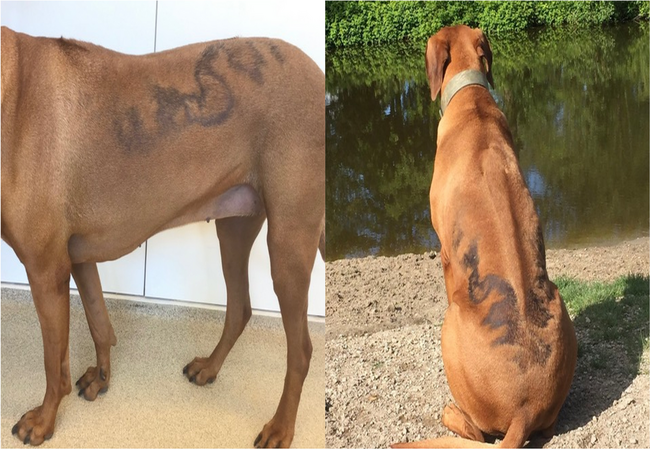Vet’s 2025 Guide to Seasonal Flank Alopecia in Dogs 🩺 Understanding, Managing & Supporting

In this article
Vet’s 2025 Guide to Seasonal Flank Alopecia in Dogs 🩺 Understanding, Managing & Supporting
By Dr. Duncan Houston BVSc
💡 What Is Seasonal Flank Alopecia?
Seasonal flank alopecia, also called canine flank, cyclic, or recurrent alopecia, is a non‑inflammatory, reversible pattern of hair loss typically affecting the flanks of dogs. It follows a seasonal rhythm tied to changes in daylight—most often in fall/winter—with spontaneous regrowth in spring/summer.
🌍 Who Gets It & Why?
- Breeds predisposed: Boxers, English/French bulldogs, Airedales, Schnauzers, and others.
- Common age: 2–6 years old, often first noticed in early adulthood.
- Geographic trend: More frequent in regions north of 45°N due to shorter daylight cycles.
- Underlying cause: Likely an abnormal follicular response to melatonin/prolactin fluctuations driven by shorter daylight—exact cause unknown.
🔍 Recognizing the Signs
- 📍 Symmetrical, well‑demarcated patches of hair loss on flanks—occasionally affecting chest, tail, or muzzle.
- 🖤 Hyperpigmented skin in affected areas—darkened color.
- 🐶 No itching, discomfort, redness, or infection unless self-trauma or secondary pyoderma occurs.
- ⏳ Recurs seasonally—most often autumn/winter—with variable regrowth timelines (3–8 months).
🧪 Diagnosis Process
Diagnosis is primarily by clinical signs and ruling out other causes:
- History & exam: seasonal pattern, breed predisposition, absence of inflammation.
- Rule out other causes: blood tests for thyroid/Cushing’s; skin scrapings for mites; fungal cultures; biopsy if atypical.
- Skin biopsy: definitive confirmation showing follicular atrophy, hyperkeratosis, and dysplastic follicles ("witches’ foot" pattern).
🩺 Treatment Options
Mostly optional, since the condition is cosmetic. Owners may choose to treat for appearance improvement:
1. Melatonin Therapy
- Oral melatonin (3 mg q12h <10 kg; 6 mg q12h >10 kg), started 4–6 weeks before expected onset.
- SC implants/injections available—effective but carry a low risk of abscess.
- Success rates ~50–60%; triggers earlier regrowth (~2–3 months).
2. Light Therapy
- Increased daylight exposure or lightbox therapy may mimic natural photoperiod and support regrowth—empirical basis.
- Bonus: sun exposure supports general coat health.
3. Environmental Support
- Warm sweaters in cold weather improve comfort in bald zones.
- Avoid harsh shampoos; use soothing, moisturizing skin-care products.
📈 Prognosis
- Excellent—non-life-threatening cosmetic condition.
- Hair may return fully, but texture/color can differ; regrowth may be incomplete or absent after years.
- Condition may recur yearly until the senior years; severity varies.
🚫 Prevention & Monitoring
- Watch for early signs in autumn and start melatonin/light therapy preemptively.
- Maintain annual wellness exams; monitor thyroid and Cushing’s status.
- Avoid known triggers like cold stress or poor grooming.
🏡 Ask A Vet Home‑Support Integration
- 🗓️ Treatment reminders for melatonin, light exposure, and check-ins.
- 📸 Photo logging of flank areas to detect early patches or regrowth progress.
- 📊 Track seasons, regrowth patterns, skin pigmentation, and hair color change.
- 🔔 Alerts when new bald patches appear or regrowth delays beyond expected time.
- 📚 Guides on light-box setup, melatonin dosing, warm clothing, and biopsy preparation.
🔑 Key Takeaways
- Seasonal flank alopecia equals symmetrical, non-itchy flank hair loss—usually cosmetic.
- Diagnosis includes history, ruling out other causes, with biopsy as the gold standard.
- Treatment is optional—melatonin and light therapy may improve regrowth.
- Maintained comfort and monitoring help with reoccurrence each season.
- Ask A Vet enhances home care through visual tracking, reminders, and remote vet support.
🩺 Final Thoughts ❤️
In 2025, seasonal flank alopecia poses no threat to dog health but may concern owners. With a better understanding of its photoperiod link, optional therapies, and robust at-home support via the Ask A Vet app, your dog can look and feel its best through every season. 🐾✨
Visit AskAVet.com and download the Ask A Vet app to track coat changes, set treatment reminders, upload photos, schedule vet follow-ups, and stay connected with expert care from home. 📲






